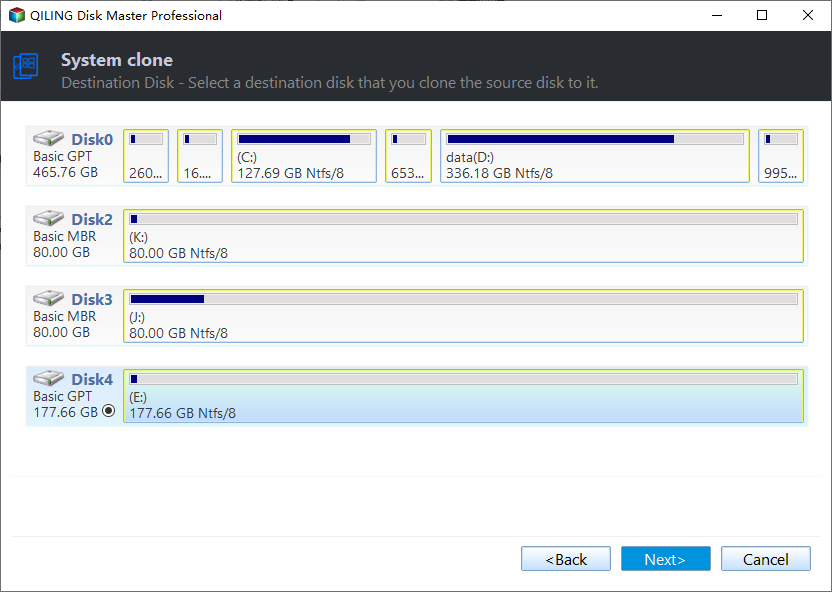How to Transfer Windows OS from GPT Disk to SSD without Reinstalling?
About GPT
There are two partition layouts for storing partitioning information on a hard drive: GUID Partition Table (GPT) and Master Boot Record (MBR). Before using a disk, you need to partition it from one of these two layouts.
MBR and GPT are two types of disk partitioning schemes. MBR is a traditional and commonly-used one, whereas GPT is more modern and flexible. Unlike MBR, GPT has no partition size or quantity limits, and its size limits depend on the operating system and file system used. For example, Windows allows up to 128 partitions on a GPT drive. Additionally, GPT stores multiple copies of boot data on the disk, whereas MBR stores it in a single location.
The MBR and GPT schemes have different levels of robustness when dealing with corrupted boot data. While MBR is more compatible with older tools and devices, GPT is more robust and can be converted to from MBR without losing data in Windows operating systems.
Why transfer OS from GPT disk to SSD?
The decision to choose between a hard disk drive (HDD) and a solid-state drive (SSD) for a computer system can be approached from two angles. Firstly, the question of why one might prefer an HDD over an SSD can be considered.
The GPT disk partition layout is becoming increasingly popular, and for good reason. While MBR has its advantages, GPT offers several benefits, making it a more attractive choice for many users. As a result, GPT disks are now the most commonly used disk partition layout, with many users opting to migrate their OS to this format.
Moving to an SSD can be beneficial, especially when you're aware of the differences between HDD and SSD. SSDs stand out due to their no-moving-part feature, making them ideal for installing an operating system due to their faster read and write speeds compared to HDDs. As a result, it's not uncommon to migrate the OS from an MBR or GPT disk to an SSD, often for improved performance. If you don't have an SSD, transferring the OS to a new hard drive can also enhance its running speed.
How to transfer OS from GPT disk to SSD without reinstalling?
Transferring an operating system from a GPT disk can be relatively easy if you find the right strategy. Similar to moving from a MBR, it involves using a reliable tool like Qiling Disk Master Professional, which allows you to migrate the GPT OS to an SSD drive with just a few clicks.
This software offers a guided Wizard to minimize risks during OS migration, allowing users to keep their OS running throughout the process. Additionally, its hot clone method enables the system to remain operational during migration, eliminating the need for a reboot after completion.
Qiling Disk Master automatically aligns partitions to optimize system performance during the migration process. To handle this task, follow these specific steps.
Step 1. To clone your system, install an SSD in your machine and launch Qiling Disk Master. From the "Tools and utilities" page, select "System clone" and click Next in the next window.
Step 2. Choose your SSD as the destination disk space.
Step 3. To resize a partition, you can either drag the double-headed arrow to adjust the size or type the desired size in the box provided. This will allow you to allocate more space to the partition where you plan to store your operating system.
Step 4. Here is a Note on how to boot OS from SSD that you need to pay attention to.
Step 5. The virtual outcome of migrating OS is now visible, showing the system previously located on Disk 2 with the drive letter F. To finalize the pending operations, click the Proceed button.
▶ Tips: To ensure the moved OS boots from the SSD, you may need to modify the boot settings or disconnect the GPT disk as suggested in Qiling Disk Master. This will allow the system to recognize the SSD as the primary boot device.
Conclusion
You can easily migrate an OS from a GPT disk to an SSD using Qiling Disk Master. This partition manager is capable of various functions, including merging partitions, converting file systems between FAT32 and NTFS, extending a partition to non-contiguous space, and converting a disk between dynamic and basic. These features make Qiling Disk Master a good alternative to Gptgen.
Related Articles
- How to Increase System Reserved Partition Windows 7/8/10?
When you try upgrading operating system, you might fail for there is not enough space on system reserved partition. So here we list the best method to help extend System Reserved partition in Windows 11/10/8/7 easily and securely. - How to Recover Deleted Files in Windows Server 2012/2008 R2?
How to recover deleted files in Windows Server 2012 R2? In fact, you can restore files from backup or previous versions and it works even for permanently deleted files. - How to Make Windows Server Backup Mapped Network Drive
Do you encounter Windows Server Backup cannot backup mapped network drive in Server 2008 (R2)/2012/2016? Find a workaround here to make Windows Server backup mapped drive. - Can I Transfer Game Saves to Another Computer? Yes, Sure!
Do you need to transfer your game saves to another computer? Follow our step-by-step guide and learn how to transfer your game saves to a new computer without reinstallation.



